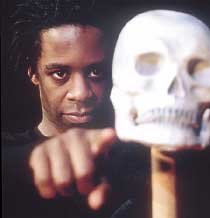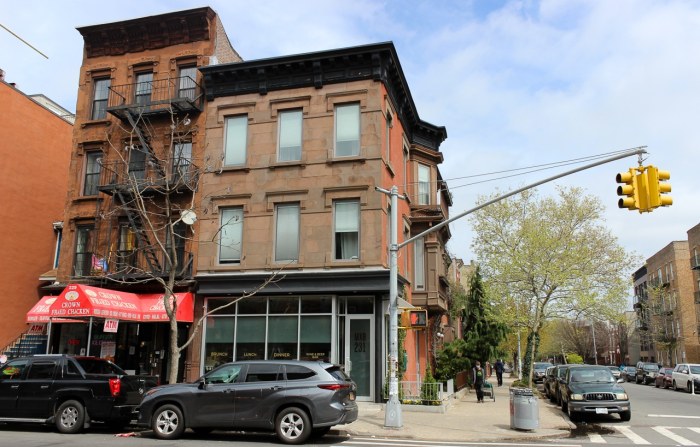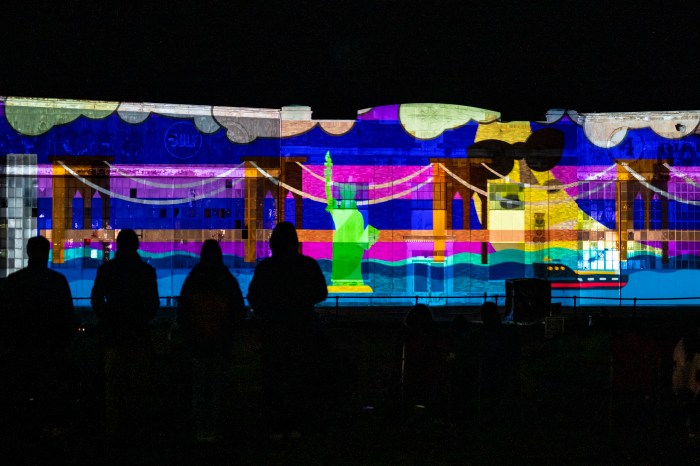Back in the 16th and 17th centuries, William
Shakespeare penned the words that made him the foremost playwright
in English literature, and for 400 years, directors and actors
have been re-interpreting those words. Of all Shakespeare’s histories,
comedies and tragedies, perhaps none has been so twisted and
tweaked as "The Tragedy of Hamlet, Prince of Denmark."
Audiences have seen Hamlet presented with
major changes in setting, time, interpretation of themes, and
even the sex of the protagonist himself. So I suppose the play
will survive Peter Brook’s production now on stage at the BAM
Harvey Theater.
Lest I be misunderstood, let me state right
here that in many ways I greatly admired Brook’s production.
It was a lively, amusing and deeply human piece. But it was not
a play to stir one’s soul.
Under the assumption that there is a leaner,
cleaner Hamlet lurking beneath Shakespeare’s expansive work,
Brook has reduced scenery to a brightly colored carpet, pillows
and a few low stools and tables on invisible wheels; and his
cast of characters to eight actors (and one musician) several
of whom double up on roles.
The minimalist setting was a most welcome
development. It intensified, accelerated and smoothed the way
for the action, highlighting both Shakespeare’s magnificent words
and Brook’s masterful choreography.
In certain cases, the dual roles worked
well, too: Jeffrey Kissoon playing both Claudius and the Ghost
is an interesting lesson in contrast and the complexity of the
human psyche. However, when Rosencrantz and Gildenstern (Naseeruddin
Shah and Rohan Siva) abruptly metamorphose into the First and
Second Player, it’s somewhat disconcerting. And for anyone in
the audience who might be approaching "Hamlet" for
the first time, it’s downright confusing.
But, of course, the whole point of this
production is that most modern audiences are all too familiar
with Hamlet, and as a result, more than a little bored with Shakespeare’s
subplots and verbiage. With this in mind, Brook has cut out about
one-third of the dialogue and moved or removed major scenes and
speeches.
Brook’s "The Tragedy of Hamlet,"
complete with French surtitles, won great acclaim last winter
when it opened at his celebrated Theatre des Bouffes du Nord
in Paris. But that’s no surprise: as a general rule, surtitles
work best when they’re used the least, and Brook’s very visual,
pared-down Hamlet certainly reduces the importance of any translation
at all. (And let’s not forget that the French regard Jerry Lewis
as a great American actor and Edgar Allan Poe as a major figure
in American literature.)
This writer, however, sorely missed Polonius’
advice to Laertes, and Fortinbras’ entrance, which restores order
to the crumbling state of Denmark at the very end of the play.
On a similar note, Laertes’ passionate and dramatic appearance
late in the play seems unaccountable and unforeseen. And without
the various officers, soldiers and courtiers, the tragedy revolves
more around a dysfunctional family than the machinations of powerful
individuals.
Perhaps the biggest problem with the production,
however, is Adrian Lester’s portrayal of Hamlet himself. Brook
says Lester first came to his attention when he saw the actor
as Rosalind in Cheek by Jowl’s all-male production of "As
You Like It" when it came to his Bouffes du Nord theater.
(The play was also presented by BAM in its 1994 New Wave Festival.)
Brook was impressed with Lester’s extraordinary
range, his singing and his movement. Indeed Lester, who played
Henry Burton in the film "Primary Colors," is a wonderful
actor. But under Brook’s direction, his Hamlet resembles more
a petulant child or a defiant adolescent than an anguished adult,
or even someone striving to be an adult. His performance is visceral
and physical. He bellows, rants, crawls, slaps his face and even
turns a cartwheel. Before launching into "To be or not to
be," he takes his pulse.
But Lester’s "To be or not to be"
sounds more like a youngster trying to decide between Frosted
Flakes and Rice Krispies than a conflicted prince contemplating
life and death.
In fact, I found Claudius’ "O, my
offense is rank" by far the most powerful speech in the
play, and Kissoon deserves credit for his powerful performances
as both Claudius and the Ghost.
Brook’s "The Tragedy of Hamlet"
is the fifth production he’s brought to BAM. His longstanding
relationship with BAM dates back to the 1970s when BAM presented
his Royal Shakespeare Company’s "A Midsummer Night’s Dream."
In 1987, BAM specifically remodeled the
Majestic Theater (renamed the BAM Harvey Theater in 1999) to
resemble Brook’s Bouffes du Nord theater for his presentation
of the nine-hour, three-part Indian epic "The Mahabharata."
And in 1988, BAM produced Brook’s adaptation of Chekov’s "The
Cherry Orchard." Most recently, in 1995, BAM welcomed to
its stage Brook’s "The Man Who," an adaptation of the
Oliver Sacks book.
After a career that has spanned half a
century, Peter Brook is not a director with whom one wants to
take issue. Certainly Shakespeare is no longer with us to defend
his work. And having a production by a director of Brook’s stature
right here in Brooklyn is definitely a delight. Yet someone must
speak up for those lost words, forgotten thoughts and obliterated
characters.
Brook has decided that he knows, better
than Shakespeare, what Shakespeare meant. Or perhaps he knows
best just how much of Shakespeare audiences in the 21st century
can enjoy or endure.
As a result, Brook’s "Hamlet"
may be the most entertaining one you’ll ever see. But it has
no nobility, no universality and no heroism. It’s a "Hamlet"
you shouldn’t miss. But it is not a "Hamlet" you’ll
never forget.
"The Tragedy of Hamlet" will
continue at the BAM Harvey Theater May 5 at 7:30 pm, and May
6 at 3 pm. BAM Harvey Theater is located at 651 Fulton St. This
engagement is sold out.






















